Wednesday 30 May 2012
Striped Hog-Nosed Skunk - A Little Loner
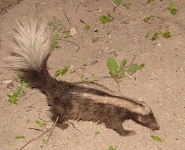
The
Striped Hog-Nosed Skunk (
Conepatus Semistriatus), also referred to as the Amazonian Hog-Nosed Skunk, is a Neotropical mammal. This means that they are generally found in Central and South America, from Southern Mexico continuing South Eastwards into Peru and Eastern Brazil. The Striped Hog-Nosed Skunk is similar in size to an average domestic house cat, perhaps slightly smaller. Their size is about 57 cm (22 inches) in length with an average weight of 1.6 kg (3.5 lbs), and the male of the species is generally larger than the female.
In appearance, the Striped Hog-Nosed Skunk is similar to the common skunk found in North America with some slight differences. Their coat is predominately black in color with the white stripe forming at the back of their necks and extending down their back where it divides into two stripes. The tail is black and white but not as bushy as that of other species and their coat is very coarse, lacking the qualities for which the North American skunk is valued. The nose is long and extends into a pig-like "snout" which is used to root in the Earth, and the front feet have strong sharp claws for digging. Like all skunks, they have anal glands which are capable of spraying a foul-smelling musk when threatened.
The habitat of the Striped Hog-Nosed Skunk changes seasonally. During dry seasons they can be predominately found in deciduous forests, shrub woodlands, and occasionally grasslands. They tend to avoid desert areas and thickly wooded forests, preferring more sparsely wooded areas. During the wet season, the skunks tend to be more selective, sticking to higher levels of elevation where food is plentiful. The omnivorous creatures feed on insects, fruit and eggs, invertebrates, and small vertebrates such as lizards and small mammals.
The Striped Hog-Nosed Skunk is quite the solitary little mammal. Being both loners and nocturnal, their mating habits and reproduction cycles are not widely documented. It is assumed that these are similar to that of other skunk species, which means that mating generally occurs in the spring and results in one litter of 2-5 offspring per year. They most likely retreat underground or into some type of den or burrow to give birth. The lifespan of this animal is not known for longevity, and at this time the Striped Hog-Nosed Skunk does not appear on any endangered species or conservation lists.
Picture of the Striped hog-nosed skunk by Washington L. S. Vieira, licensed under
Creative Commons Attribution 2.0 Generic license.
You can help spreading the word about this animal by liking it on facebook
Permanent Link
Friday 25 May 2012
The Weeping capuchin- a Social Learner
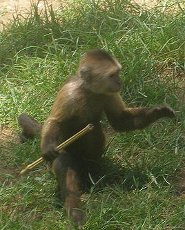
Weeping capuchins (
Cebus olivaceus) are also called wedge-capped monkeys because of the dark hair on the top of their head resembling a monk’s cap. They are native to the semi-deciduous, tropical forest of South America in
Venezuela,
Guyana, and the Amazon Basin. Coloration is tan or cream, with a white face and chest and a wedge of dark hair on the top of the head. Weeping capuchins weigh an average of 2.5 to 3 kg (5.5-6.6 lbs.), with the male weighing up to 800g (1.7 lbs.) more than the female. Average length is 500 mm (19.6 in) and tails are as long as the body making the over-all length 840 mm (33 in). Their tail is prehensile, which means it can support their entire hanging weight. This skill is handy as they can use both hands to pick and eat food. Fruit, nuts, flowers, buds, bark, bird eggs, small vertebrates, insects, spiders, and crabs make up their diet. Weeping capuchin monkeys live in bands or troops, consisting of 10 to 30 members. Most of the members are females with their young, a few males, and a dominant male. The dominant male is the only one that mates with the females. Mating season is from October to February, but may be year-round, and females have one offspring every 18-24 months. Gestation is 145-170 days. The infants are able to grasp onto their mother’s chest within minutes of birth and spend the first few months clinging to her. Females mature in four years, males in 7. Weeping capuchins may live 45 to 55 years in captivity, while life expectancy in the wild is 34-36 years.
These mischievous little monkeys are very intelligent and often used in laboratories, research, shows at zoos, and in the motion picture industry. One
famous little capuchin is Marcel, who played the pet monkey in the American television series “Friends.” Capuchin monkeys are often sold as pets, but they can be very destructive. Many, like Marcel in the series, are eventually donated to a zoo.
The main predators of the weeping capuchin monkey in the wild are humans. Some native populations hunt them for food and others are captured for labs and pets. Natural predators are large snakes, falcons, cats, and rodents. They are currently listed as “Least concern” on the IUCN Red List of Endangered Species.
Weeping capuchins are very social and groom each other. They make vocalizations that sound like someone weeping, which led to their common name. These monkeys are so smart that they have learned to crush a centipede and smear it on their bodies to repel mosquitoes.
You can help spreading the word about this animal by liking it on facebook
Permanent Link
Thursday 24 May 2012
Guadeloupe raccoon Raccoon - Newly Discovered Subspecies of Raccoon
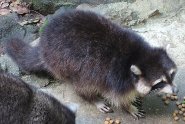
The Guadeloupe raccoon (
Procyon minor) or (
Procyon lotor minor) was only recognized by biologists as its own subspecies in 1999. At first, it was thought to be the
common raccoon (
Procyon lotor) of North and Central America. It also closely resembled the Bahaman raccoon (Procyon lotor mayardi.) The Guadeloupe raccoon is smaller than the common raccoon and has a thinner skull. It lives only on Basse-Terre Island and Grande Terre Islands in the Lesser Antilles in the Caribbean.
Now that we have just discovered the Guadeloupe raccoon, it may go extinct because of hunting by people and from destruction of its mangrove forest homelands. Many are killed from vehicles. It also cannot compete with the larger invasive species of the
crab-eating raccoon (Procyon cancrivorus) which was somehow released on the islands. The Guadeloupe raccoon is an endangered species, with an estimated population of 2500 left in the world.
Physical Description
This raccoon is much smaller than the common raccoon and has longer, thicker fur. Like the common raccoon, it has a black mask across the eyes with white “eyebrows” highlighting the dark mask. The chin, inner ears, feet and belly are a pale grey, while the rest of the fur is dark gray, sometimes with blue or tan tints. The solid-colored tail is long, curves slightly like a fish hook and is heavily furred.
Adults vary in weight from 6.6 to 8.8 pounds (3 to 4 kilograms) and a total body length, including tail, of 36 inches (91.44 centimeters.) Males are usually larger than females, but some females grow as large as males. Both males and females have sharp teeth and claws for digging, holding onto food and climbing trees. Although the paws look like human hands, they lack a thumb. Babies or kits look like miniature versions of their parents.
Life Cycle and Behavior
Unfortunately, there is not much known about the behavior of Guadeloupe raccoons, since they are so rare and are mostly active at night. They eat a wide variety of foods, including shellfish, nuts, seeds, fruits, vegetables, eggs, bird hatchlings, spiders, frogs and insects. Despite their dense fur, they are excellent swimmers. Females are thought to live alone with their kits, but males will sometimes band together for protection and to protect a food-rich territory.
Raccoons in general have poor vision but excellent hearing and smell. They are thought to be able to hear worms crawling through soil. They mark their territories with urine, feces and the oil from glands near their tails. It is unknown how long Guadeloupe raccoons live.
Picture of the Guadeloupe raccoon by Liné1 at Parc des Mamelles in Guadeloupe, Basse-Terre, licensed under the
Creative Commons Attribution-Share Alike 3.0 Unported license and GFDL.
You can help spreading the word about this animal by liking it on facebook
Permanent Link
Monday 21 May 2012
Yellow-footed Rock Wallaby -- Hops in 20-Foot Bounds
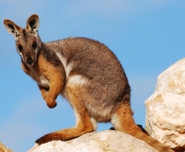
The yellow-footed rock wallaby (
Petrogale xanthopus) does have dark yellow feet and prefers to live in rocky habitats in Southern
Australia. It is a magnificent natural athlete. From a standstill, it can leap more than twice its full height. It can push off vertical rocks with their hind feet to make spectacular 20-foot (6.09 meters) bounds – about as long as a horse’s stride.
Once an abundant species, the yellow-footed wallaby is now found in tiny areas in Queensland and New South Wales. There are less than 10,000 left in the world. Despite their athleticism, they could not compete with European colonists and the animals they brought with them. Humans destroyed an estimated 90% of the yellow-footed rock wallaby’s original habitat. The babies or joeys were easy prey for domestic dogs, feral cats and
European foxes. Goats and sheep managed to eat all of the available vegetation, leaving none for the wallabies. Humans used to hunt the wallabies for their luxurious pelts, but hunting stopped by 1930.
Physical Description
Yellow-footed rock wallabies look like small, differently colored kangaroos. The large ears are shaped like a rabbit’s ears. They have very long hind legs and tails. Their eyes are dark and their noses are black. The tails are used for balance when making tight turns at full speed. Their bodies are light grey with a pale underside. Separating these two colors is a white stripe. The legs, some of the head and most of the tail are shades of dark yellow bordering on orange. This coloration helps the wallabies blend in with their rocky surroundings. It is very difficult to spot one when it stands still.
Adults grow to a mere 2 feet (0.6 meters) tall and weigh from 15.4 to 27.8 pounds (7 to 13 kilograms.) Since there is safety in numbers, adults and joeys live in groups called mobs. If one member of the mob spots danger, it stamps its long, thickly-padded hind food to warn the others.
Life Cycle and Behavior
Mothers give birth to tiny 30 day old embryos which have to wriggle through the mother’s fur, crawl inside of her pouch and find a teat to suckle from. The joey stays in this pouch for 6 to 7 months and then is turned out by the mother. During this time, the mother often comes into season and mates. Instead of going through the strain of caring for two joeys, she can delay the development of the new embryo until the first joey leaves the pouch. Even with this strategy, joeys often die before they are a year old.
Yellow-footed rock wallabies prefer to sleep during the day and hide at night. They are most active at dawn and dusk, when visibility for their native predators is poor. They eat a wide variety of plants.
Picture of the Yellow-footed Rock Wallaby by
Peripitus at Monarto Zoo, South Australia, licensed under the
Creative Commons Attribution-Share Alike 3.0 Unported license and GFDL.
You can help spreading the word about this animal by liking it on facebook
Permanent Link
Tuesday 15 May 2012
Western Pocket Gopher - Small Rodent that Can Cry
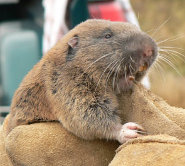
The Western pocket gopher (
Thomomys mazama) is also called the Puget Sound pocket gopher and the Mazama pocket gopher. There are five subspecies still alive in the wild, but all of the subspecies look remarkably alike. A sixth subspecies, the Tacoma pocket gopher (
Thomomys mazama tacomensis) sadly became extinct in 1970. Although the International Union for the Conservation of Nature classifies the Western pocket gopher as not endangered, individual subspecies are threatened or endangered.
All of the subspecies live on the West Coast of the
United States and
Mexico. They prefer open grasslands, meadows, marshlands, prairies and anywhere that has soil lose enough for digging and moist enough to grow a variety of the plants they eat. They munch on grasses, tree bark, young tree roots and some plants like lupines and false dandelions. They in turn are munched on by badgers, foxes,
coyotes, skunks, large birds of prey and feral cats. Farmers kill Western pocket gophers if thy find any in their crops and orchards.
Physical Description
Western pocket gophers resemble furry tubes with short legs. It has a nearly hairless tail at one end and protruding incisors at the other. The large teeth aid the rodent to dug tremendously long burrows. They dig by biting into the soil and shoveling it backwards with their forefeet. The burrows are used not only by western gophers, but many other insect, reptile and mammal species that need to live underground. The eyes are tiny in comparison with the rest of the body. They are able to cry like people, but probably not for emotional reasons. The “crying” helps remove dirt from the pocket gopher’s eyes.
Males grow larger and heavier than females. Females average 6 inches (15.24 centimeters) in length while males can grow up to 9 inches (22.86 centimeters) long. Females can weigh around 2.65 ounces (75 grams) while males can tip the scales at 4.41 ounces (125 grams.) Both sexes sport a dirt-brown coat of fur and nearly hairless pink legs.
Life Cycle and Behavior
Biologists do not know a lot about the life cycle and normal behavior of pocket gophers. It is known that these little rodents can dig burrows up to 50 feet (164 kilometers) long. They are fiercely territorial and only come together briefly for breeding. Males have large territories overlapping several females’ territories. Males need to be 12 months old to breed, but females can become pregnant at a mere 10 weeks of age.
After a brief gestation of about 20 days, females give birth to hairless, blind and deaf babies. She can have anywhere from 2 to 7 babies. If food is plentiful, she can have two litters per year. Babies begin eating solid food at 21 days old. The mother weans them when they are only six weeks old.
You can help spreading the word about this animal by liking it on facebook
Permanent Link
Friday 11 May 2012
Nilgai -- The Horse-like, Camel-like Antelope
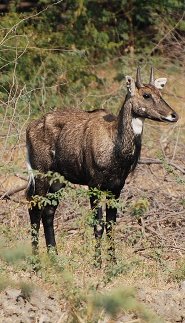
The Nilgai (
Boselaphus tragocamelus) is a member of the bovine family, has a face similar to a horse, a camel hump-like area atop its broad shoulders, but is actually an antelope. The Nilgai is the largest Asian antelope and is native to
India and
Pakistan, where they number between 10,000 to 15,000. Tigers are their only natural predators, and the Nilgai prefer grasslands and bush lands to forested areas, so they are relatively safe there. The Nilgai is a bovine, so in many areas in India it is considered a sacred animal, and is therefore protected. Nilgai translates in Hindi to “blue cow,” and adult Nilgai bulls are actually a bluish-gray color. The cows and the calves are a light brownish-red color. Both sexes have white markings on parts of the head, chest, and belly, and a have a short raised mane on their neck. Bulls have horns that are 8-10 inches long (20-25cm) and a long tuft of hair hanging from the lower chest.
Nilgai were imported to southern Texas, USA during the 1930s-1940s as game animals. Now they number close to 37,000 on ranches and in the wild. Since Nilgai are native to a different climate, an extremely cold winter in South Texas may kill many. However, they have no natural predators in Texas, so their numbers are increasing. Nilgai are hunted as game, and hunting ranches in South Texas will arrange guided hunts. Also, Nilgai meat and hide products are for sale at certain ranches in Texas, and through on-line sources.
The average size for a Nilgai is 180-200 cm (6-6.5 ft.), and weight is about 120-240kg (264-528 lb.), with the males being larger than the females. Calves weigh 13-16 kg (30-35 lb.) at birth. Mating takes place year round, but the peak is December-March. The bulls compete for the females in mating season by posturing, neck wrestling, and occasionally resort to fighting with their horns. Rarely, they fight to the death. Gestation period is 245 days (8 months), and females usually give birth to two calves. Family groups are composed of one male and several cows and calves with 4-20 animals per group. The Nilgai becomes sexually mature around 3-4 years of age and has a life span of 21 years.
In India and Texas, Nilgai compete with the cattle for food sources. They eat shoots, buds, flowers, fruit, and farmer’s crops when food is scarce. Some Indian farmers have built 6-7 ft. fences to prevent Nilgai from eating their crops, but since it is an antelope, it easily jumps these fences. The Nilgai is truly a remarkable as well as unusual looking animal.
Picture of the Nilgai by Thomas Schoch, licensed under the
Creative Commons Attribution-Share Alike 3.0 Unported license and GFDL.
You can help spreading the word about this animal by liking it on facebook
Permanent Link
Thursday 10 May 2012
Sri Lankan Giant Squirrel - Smallest Giant Squirrel in Asia
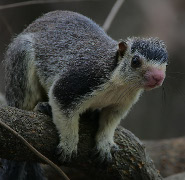
The Sri Lankan giant squirrel (
Ratufa macroura) is a much larger tree squirrel than North Americans or Europeans are used to seeing, but it is small in comparison to the
Indian giant squirrel (
Ratufa indica.) Also called the grizzled squirrel due to its coloration, there are three recognized subspecies,
Ratufa macroura macroua,
Ratufa macroura dandolena and
Ratufa macroura melanochra. The subspecies differ slightly in how thick their coats are. All of the subspecies live on the island of
Sri Lanka (formerly called Ceylon.)
All three of the subspecies is listed as near threatened, which is not as bad as being endangered but still worse than common. The Sri Lankan giant squirrel population is plummeting due to poaching and destruction of their forests. Two of the subspecies live in lowland forests while the third lives in the highlands. The squirrels are frequent visitors to hotels and tourist spots in Sri Lanka.
Physical Description
The Sri Lankan giant squirrel has a body shape like the more familiar North American gray squirrel, but it is much larger and has a different color. The underside is a pale grey, silver, yellow or tan. The top of the head, back and sides are black. The contrast in colors is so sharp that the squirrel appears to be striped. The nose is pink. The ears are round with small tufts protruding from them.
Adults grow to a body length of 9.8 to 18 inches (25 to 45 centimeters.) This excludes the white-topped tail, which grows to be the same length as the rest of the body. The long tail is used as a counterbalance while the squirrel moves through branches. Adults reach weights of 3.3 to 6.61 pounds (1.5 to 3 kilograms.)
Life Cycle and Behavior
Not much is known about the reproductive behavior of Sri Lankan giant squirrels, but it is known that females have a gestation that averages 28 days. Females make nests or dreys high in trees and give birth to one or two babies. The female does most of the work taking care of her babies. It is unknown how long she nurses the babies, but she does take care of them for six to nine months.
Sri Lankan giant squirrels live solitary lives with large territories. They are active during the day, spending a large part of the time searching their territory for food. They eat a wide variety of foods, including nuts, fruits, bird eggs, bird chicks, insects and tree bark from some species of trees. It is unknown how long Sri Lankan squirrels live.
Picture of the Sri Lankan Giant Squirrel by
Steve Garvie , licensed under the
Creative Commons Attribution-Share Alike 2.0 Generic license.
You can help spreading the word about this animal by liking it on facebook
Permanent Link
Wednesday 09 May 2012
Green Acouchi -- Monogamous Rodents of South America
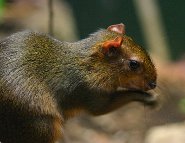
The green acouchi (
Myopracta acouchy) is also known by the Linnaean classification
Myopracta pratti, which is the scientific name for the red acouchi. There may be two species that are currently recognized as green acouchi that look very much alike. Taxonomists are still trying to clear up the classification mess. Meanwhile, the green acouchi has adapted well to changes in the long history of its existence. They do well in captivity which makes this species not endangered.
The green acouchi can still be found in in the forests of Peru, Ecuador, Columbia and Brazil. It depends on this habitat in order to find enough food and shelter to survive. If these forests continue to be destroyed, then the green acouchi may become extinct in the wild. They also are main food sources for other forest species such as the
jaguar, the
white-nosed coatis and the
South American coatis. They are also hunted for their meat by people and their dogs.
Physical Description
The green acouchi looks like a cross between a guinea pig and a North American gray squirrel. It has a squirrel’s wedge-shaped profile, wide dark eyes and small ears. It has the guinea pig’s rounded, and preference for living in underground burrows. The nose is mostly hairless and pink. The rest of the body is colored in a strange agouti pattern. Usually, an agouti coloration consists of hairs banded with brown, black and white. The green acouchi has hairs banded in brown, black and olive green. This color helps it blend in with the undergrowth.
Adult males and females look alike. Adults weigh around 1.76 to 2.64 pounds (0.8 to 1.2 kilograms.) The total nose to rump body grows up to 15.08 inches (383 millimeters) long. Both males and females have tiny tails that are very hard to see. Adults that live near the Andes have orange spots on their ears while those in the lowlands have yellow spots.
Life Cycle and Behavior
The green acouchi is active during the day and sleeps in underground burrows at night. Its toes are strong and hoof-like in order to dig. In the day, it keeps hidden against clumps of vegetation and inside of overgrowth. It has a wide vegetarian diet consisting of grasses, fruits, seeds, roots and stems. It prefers to live near water where vegetation grows best and the soil is softer for digging.
Green acouchis choose their mates when they are about 8 to 12 months old. Unlike most other rodent species, acouchis pair for life. They breed throughout the year. Females have a long gestation of 99 days in order to give birth to fully-furred young that can run within an hour of being born. The babies are weaned when they are two months old.
Picture of the green acouchi by Brian.gratwicke, licensed under the
Creative Commons Attribution 2.5 Generic license.
You can help spreading the word about this animal by liking it on facebook
Permanent Link
Tuesday 08 May 2012
Midas Tamarin -- Little Monkeys with Big Parenting Instinct
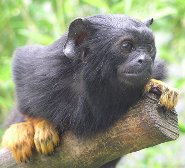
The Midas tamarin (
Saguinus midas) is also called the red-handed tamarin or golden-handed tamarin. No matter what name it is called, it is a lively little New World monkey with strong parental skills. Unlike many other species of mammals, the male takes care of the babies more than the females. Mothers do nurse their offspring. The Midas tamarin does best in small groups. Each adult helps in protecting and caring for each juvenile. Only one female in a group breeds during a breeding season, which helps ensure the babies’ survival.
Although they can do well in captivity, they do best in their natural habitat. Wild Midas tamarins can still be found in the forests of
Suriname,
Brazil,
Guyana and
French Guiana. They are currently not endangered, but if their habitat continues to be destroyed, these little monkeys will not be able to find enough food and shelter to survive.
Physical Description
These are slim. long-tailed little monkeys but seem larger because of their fluffy, dark brown and black fur. Their hands and feet are markedly different in color than the rest of the tamarin. Color varies from a bright gold to a chestnut red. White or pale gray fur grows around the mouth. They have rounded heads, blunt profiles and round eyes. Their hairless ears protrude through their fur.
Males and females look alike. They grow to a body and tail length between 20.47 to 28.34 inches (52 to 72 centimeters.) Adults weigh from 14.10 to 19.38 ounces (400 to 550 grams.)
Life Cycle and Behavior
Midas tamarins are active during the day and sleep in trees at night. Midas tamarin groups consist from 6 to 15 monkeys. Individuals mark their territory with musk glands underneath the tail. They prefer to forage in trees rather than on the ground. They eat a wide variety of foods, including new leaves, new shoots, fruits, nectar, flowers, insects, spiders, bird eggs, bird chicks, small lizards and frogs.
Males and females become sexually active when they are between 16 and 20 months old. Females give birth to twins and occasionally triplets. Babies weigh about 1.58 ounces (45 grams.) Males protect babies from predators such as large snakes, domestic cats and hawks.
People also capture Midas tamarins for the exotic pet market. In the wild, Midas tamarins live to be 10 years old and live an extra six or seven years in captivity.
Picture of the midas tamarin by
Frank Wouters, licensed under the
Creative Commons Attribution 2.0 Generic license.
You can help spreading the word about this animal by liking it on facebook
Permanent Link
Monday 07 May 2012
Greater Spear-nosed Bat -- Fierce-looking Pollinator of Crops
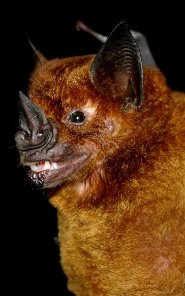
The greater-spear nosed bat (
Phyllostomus hastatus) has a face straight out of a low-budget horror movie. This scary-looking creature is far from harmful to people. Without this species of
bat, some crops cannot get pollinated. This bat likes drinking flower nectar. When they hover over a flower to lap nectar, their bodies collect pollen, which is then transferred to other flowers of the same species. The greater spear-nosed bat also eats night-flying insect pests.
This is not an endangered species of bat, but soon could become endangered if more of their habitat is destroyed. Some bats have been found roosting in South American homes, but many homeowners chase the bats out. They are still found in forests and near bodies of water in
Honduras,
Colombia,
Bolivia,
Guyana,
Panama,
Paraguay,
Venezuela and
Trinidad and Tobago. Adults are killed by people, but baby bats (pups) can be killed by female bats that live outside of the pups’ social group.
Physical Description
Adult greater spear-nosed bats have a light brown furry head and body with a pale belly. They have small, round, dark eyes, large pointed ears and a black hairless nose that is shaped like a spear-tip. The profile has a wide forehead tapering to a slightly pointed nose. The lips are black. The lower lip has a V-shaped notch in the center and is covered in warts. Their tails are short and difficult to see. The wings are hairless, black and leathery.
Males and females look alike, except that makes have a larger throat pouch located over the breastbone. Adults grow to a body length range of 3.9 to 5.1 inches (about 100 to 130 millimeters) and a wingspan that grows up to 17.9 inches (455 millimeters.) Adults weigh an average of 2.9 ounces (89 grams.)
Life Cycle and Behavior
Greater spear-nosed bats spend the nights searching for their food, which consists mostly of fruit like bananas, flower nectar and pollen. Females also eat insects when they are pregnant and nursing, but it is unclear if males also eat insects. The huge ears and forehead work as a sonar. The bat sends out a series of clicks and navigates by hearing the echoes of these clicks.
The breeding season begins in October and lasts until February. Males have harems of up to 30 females. Many harems may share a roosting space but can squabble among each other. Females will take care of the pups of other females in their harem, but will attack pups not of the harem. After a gestation of 120 days, females give birth to a single pup. Pups often fall from the roost and a female has to pick the pup up or it will soon die. With luck, a greater spear-nosed bat can live to be 18 years old.
Picture of the greater spear-nosed bat by Felineora, licensed under the
Creative Commons Attribution 3.0 Unported license.
You can help spreading the word about this animal by liking it on facebook
Permanent Link
Wednesday 02 May 2012
Long-nosed Potoroo -- Marsupial Tiller of the Soil
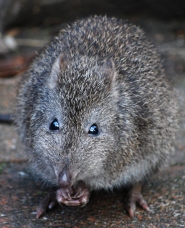
The long-nosed potoroo (
Potorous tridactylus) is a small marsupial that performs a big job for the Australian environment. This small, peculiar-looking marsupial constantly digs at the ground looking for food. In this way, it acts as an earthworm to help till the soil.
Australia does not have any earthworms but does have termites and the long-nosed potoroo, which is a lot more physically attractive than a termite.
There are four different species of potoroo in Australia. The name is similar to “kangaroo” and the two types of “roos” share many similarities. They both grow their babies or joeys in pouches rather than in a womb. They both hop. But unlike the kangaroo species, potoroos are all in danger of extinction because of habitat loss and falling prey for cats and foxes. These formidable predators were introduced to Australia with the first European colonists. Long-nosed potoroos need areas of thick undergrowth to grow the food they need. These areas are rapidly disappearing.
Physical Description
The long-nosed potoroo looks like a cross between an elephant shrew and a kangaroo. It has wide forehead that tapers to a long, pointed nose. The tip of the nose is hairless and pink. The body is covered in short fur colored in shades of brown and gray. The forelegs are much shorter than the hind legs but are muscular enough for digging. The long, slim tail is mostly furred. Males and females are hard to tell apart.
Males and females grow to a similar size and weight. Adults weigh up to 2.86 pounds (1.3 kilograms.) From nose to rump, adult long-nosed potoroos grow to a length of 14.17 inches (36 centimeters.) This is about as large as a rabbit. The long tail can grow up to 9.05 inches (23 centimeters.) Long-nosed potoroos can use the tail to help balance when they sit up to use their forelegs for eating, digging or hopping.
Life Cycle and Behavior
Long-nosed potoroos are mostly active at night, although sometimes they come out from their burrows during the day. They prefer to move under cover of long grasses or plants. They create escape routes to underground burrows in these grasses, meticulously removing any debris from these paths that may trip them up as they race away from predators. They feed mostly on fungus, but also on bulbs, roots, seeds and occasionally insects.
Males become sexually mature when they about 11 months old. Females need to be between one and 2 years old. They breed year round. After a 38 day gestation, the female gives birth to one or two embryos, which crawl into her pouch, find a teat and remain there for the next four months. Mom turns them out of the pouch when they are 6 months old. In captivity, long-nosed potoroos live up to 7 years.
Picture of the long-nosed potoroo by Peripitus, licensed under GFDL and the
Creative Commons Attribution-Share Alike 3.0 Unported
You can help spreading the word about this animal by liking it on facebook
Permanent Link
 The Striped Hog-Nosed Skunk (Conepatus Semistriatus), also referred to as the Amazonian Hog-Nosed Skunk, is a Neotropical mammal. This means that they are generally found in Central and South America, from Southern Mexico continuing South Eastwards into Peru and Eastern Brazil. The Striped Hog-Nosed Skunk is similar in size to an average domestic house cat, perhaps slightly smaller. Their size is about 57 cm (22 inches) in length with an average weight of 1.6 kg (3.5 lbs), and the male of the species is generally larger than the female.
The Striped Hog-Nosed Skunk (Conepatus Semistriatus), also referred to as the Amazonian Hog-Nosed Skunk, is a Neotropical mammal. This means that they are generally found in Central and South America, from Southern Mexico continuing South Eastwards into Peru and Eastern Brazil. The Striped Hog-Nosed Skunk is similar in size to an average domestic house cat, perhaps slightly smaller. Their size is about 57 cm (22 inches) in length with an average weight of 1.6 kg (3.5 lbs), and the male of the species is generally larger than the female.
 Weeping capuchins (Cebus olivaceus) are also called wedge-capped monkeys because of the dark hair on the top of their head resembling a monk’s cap. They are native to the semi-deciduous, tropical forest of South America in
Weeping capuchins (Cebus olivaceus) are also called wedge-capped monkeys because of the dark hair on the top of their head resembling a monk’s cap. They are native to the semi-deciduous, tropical forest of South America in  The Guadeloupe raccoon (Procyon minor) or (Procyon lotor minor) was only recognized by biologists as its own subspecies in 1999. At first, it was thought to be the
The Guadeloupe raccoon (Procyon minor) or (Procyon lotor minor) was only recognized by biologists as its own subspecies in 1999. At first, it was thought to be the  The yellow-footed rock wallaby (Petrogale xanthopus) does have dark yellow feet and prefers to live in rocky habitats in Southern
The yellow-footed rock wallaby (Petrogale xanthopus) does have dark yellow feet and prefers to live in rocky habitats in Southern  The Western pocket gopher (Thomomys mazama) is also called the Puget Sound pocket gopher and the Mazama pocket gopher. There are five subspecies still alive in the wild, but all of the subspecies look remarkably alike. A sixth subspecies, the Tacoma pocket gopher (Thomomys mazama tacomensis) sadly became extinct in 1970. Although the International Union for the Conservation of Nature classifies the Western pocket gopher as not endangered, individual subspecies are threatened or endangered.
The Western pocket gopher (Thomomys mazama) is also called the Puget Sound pocket gopher and the Mazama pocket gopher. There are five subspecies still alive in the wild, but all of the subspecies look remarkably alike. A sixth subspecies, the Tacoma pocket gopher (Thomomys mazama tacomensis) sadly became extinct in 1970. Although the International Union for the Conservation of Nature classifies the Western pocket gopher as not endangered, individual subspecies are threatened or endangered. The Nilgai (Boselaphus tragocamelus) is a member of the bovine family, has a face similar to a horse, a camel hump-like area atop its broad shoulders, but is actually an antelope. The Nilgai is the largest Asian antelope and is native to
The Nilgai (Boselaphus tragocamelus) is a member of the bovine family, has a face similar to a horse, a camel hump-like area atop its broad shoulders, but is actually an antelope. The Nilgai is the largest Asian antelope and is native to  The Sri Lankan giant squirrel (Ratufa macroura) is a much larger tree squirrel than North Americans or Europeans are used to seeing, but it is small in comparison to the
The Sri Lankan giant squirrel (Ratufa macroura) is a much larger tree squirrel than North Americans or Europeans are used to seeing, but it is small in comparison to the  The green acouchi (Myopracta acouchy) is also known by the Linnaean classification Myopracta pratti, which is the scientific name for the red acouchi. There may be two species that are currently recognized as green acouchi that look very much alike. Taxonomists are still trying to clear up the classification mess. Meanwhile, the green acouchi has adapted well to changes in the long history of its existence. They do well in captivity which makes this species not endangered.
The green acouchi (Myopracta acouchy) is also known by the Linnaean classification Myopracta pratti, which is the scientific name for the red acouchi. There may be two species that are currently recognized as green acouchi that look very much alike. Taxonomists are still trying to clear up the classification mess. Meanwhile, the green acouchi has adapted well to changes in the long history of its existence. They do well in captivity which makes this species not endangered. The Midas tamarin (Saguinus midas) is also called the red-handed tamarin or golden-handed tamarin. No matter what name it is called, it is a lively little New World monkey with strong parental skills. Unlike many other species of mammals, the male takes care of the babies more than the females. Mothers do nurse their offspring. The Midas tamarin does best in small groups. Each adult helps in protecting and caring for each juvenile. Only one female in a group breeds during a breeding season, which helps ensure the babies’ survival.
The Midas tamarin (Saguinus midas) is also called the red-handed tamarin or golden-handed tamarin. No matter what name it is called, it is a lively little New World monkey with strong parental skills. Unlike many other species of mammals, the male takes care of the babies more than the females. Mothers do nurse their offspring. The Midas tamarin does best in small groups. Each adult helps in protecting and caring for each juvenile. Only one female in a group breeds during a breeding season, which helps ensure the babies’ survival. The greater-spear nosed bat (Phyllostomus hastatus) has a face straight out of a low-budget horror movie. This scary-looking creature is far from harmful to people. Without this species of
The greater-spear nosed bat (Phyllostomus hastatus) has a face straight out of a low-budget horror movie. This scary-looking creature is far from harmful to people. Without this species of  The long-nosed potoroo (Potorous tridactylus) is a small marsupial that performs a big job for the Australian environment. This small, peculiar-looking marsupial constantly digs at the ground looking for food. In this way, it acts as an earthworm to help till the soil.
The long-nosed potoroo (Potorous tridactylus) is a small marsupial that performs a big job for the Australian environment. This small, peculiar-looking marsupial constantly digs at the ground looking for food. In this way, it acts as an earthworm to help till the soil.